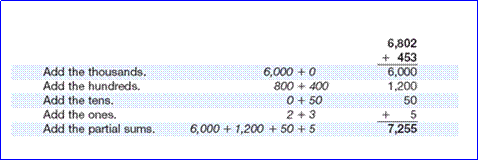In Everyday Mathematics (EDM) students are introduced to many different methods for addition. As they get older, they are introduced to addition algorithms. EDM introduces different methods for addition since some are well suited for mental arithmetic or larger numbers. Some are easier to learn, but not as efficient as others. EDM picks one algorithm as its focus algorithm. Focus algorithms are powerful, relatively efficient and easy to learn and understand. The focus algorithm for addition is the partial sums method. Students are taught this method and expected to show that they know how to use it, starting in second grade. In problem solving, however, students may use any algorithm they chose. The aim of this approach is to promote flexibility while ensuring students know at least one reliable method for each operation.
An Example of Partial Sums Addition
As the name suggests, the partial sums method calculates partial sums, working one place value column at a time, and then adds all the partial sums to find a total.
Partial sums can be added in any order, but working from left to right is the usual procedure. This order seems natural since we read from left to right, and it also focuses on the most important digits in the addends first (thousands before hundreds, hundreds before tens, and so on). The partial sums addition method can be readily adapted for mental arithmetic.
It is also the most similar to addition with base- 10 blocks. Finding each partial sum corresponds to combining all of one kind of base-10 block. Adding the partial sums corresponds to exchanging blocks as necessary and then combing blocks. This is a wonderful connection that our second graders work on making when they first are introduced to partial sums.
Examples of all of the algorithms are available online. If you go to the PES website (https://sau51.org/pes/) choose the “Curriculum” dropdown menu, and “Everyday Mathematics”. This will bring you to a page with many useful links. The first link will bring you to a page that demonstrates the different algorithms taught to students.
This article was adapted from the Everyday Mathematics Teacher Handbook

